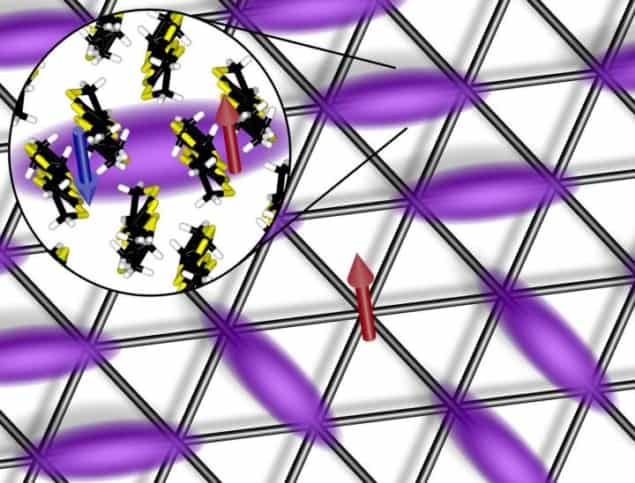
Quantum spin liquids (QSLs) – materials that display no magnetic order, even at the lowest temperatures – are widely regarded as important testbeds for condensed-matter physics. The electron–electron interactions that characterize them play a vital role in high-temperature “unconventional” superconductors, and QSLs themselves have promising applications in information technology and quantum computing.
There’s just one problem: it is very hard to prove that such materials exist, and new research by physicists at the University of Stuttgart, Germany, has now cast doubt on one of the more promising candidates. Using a broadband electron spin resonance (ESR) spectroscopy technique they developed themselves, the researchers studied the behaviour of electron spins along different directions in a crystal at ultracold temperatures. Their results showed that a key QSL signature – a gap-free spectrum of electron spin excitations – is absent in a material that was previously considered a strong possibility to be a QSL.
Predicted behaviour
The late physicist and Nobel laureate Philip W Anderson proposed the existence of QSLs in the early 1970s while studying the ground state of antiferromagnetically interacting spins (magnetic moments) in a triangular crystal lattice. In this geometry, any two neighbouring spins can align in opposite directions, but the third will always end up parallel to one of them and not the other – no matter which way the spins are turned.
This situation, known as “geometrical frustration”, implies that one of the three spins must remain unpaired, and so create a defect in the lattice. It also implies that a material with this structure should behave very differently from an ordinary antiferromagnet in which spins point “up” and “down” in an alternating fashion.
Quantum mechanics solves this (literally) frustrating problem by suggesting that the orientation of the spins is not rigid. Instead, the spins are constantly changing direction in a fluid-like way, forming an entangled ensemble of spin-ups and spin-downs. Thanks to this behaviour, a material with this structure will remain in a liquid state even at temperatures near absolute zero, where most materials freeze solid. A further consequence is that the freely moving spin excitations, or spinons, can be considered as (uncharged) analogues to electrons in a metal.
Promising candidates
So far, only a few real materials have been put forward as candidates for meeting Anderson’s criteria. One promising example is a complex organic charge-transfer salt with the chemical formula k-(BEDT-TTF)2Cu2(CN)3. However, its ground-state properties are puzzling, and several advanced techniques – including methods that measure magnetic torque, muon spin rotation (mSR), thermal transport, specific heat and nuclear magnetic resonance (NMR) – have produced conflicting conclusions.
According to Martin Dressel, who led the new study, the confusion arises because it is so challenging to measure the properties of electron spins at extremely low temperatures – especially along different crystal directions and in variable magnetic fields. The new broadband ESR spectroscopy technique he and his colleagues developed makes such measurements possible because it is sensitive to unpaired magnetic moments of any kind.
Dressel goes on to explain that the spins of individual atoms or molecules have a preferred orientation in an external magnetic field. When his team applies a time-varying microwave electric field to the material under study, the microwaves cause the spins to rotate. This rotation gives rise to a resonance with a frequency and quality that yields important insights into the local properties of the spins.
Spin gaps emerge
When the physicists tested their technique on a sample of k-(BEDT-TTF)2Cu2(CN)3, they found that at 6 K, the material’s spins do not arrange themselves in the up-down pattern of a typical antiferromagnet – but nor do they form a dynamic state resembling a liquid. Instead, the pairs of spins have different energies, forming a “gap” in the spectrum of spin excitations. This gap means that k-(BEDT-TTF)2Cu2(CN)3 may not be a QSL after all, Dressel says.
The new results are in line with recent thermal conductivity measurements that indicated a similar spin gap in another QSL candidate, b′-EtMe3Sb[Pd(dmit)2]2. “Even larger spin defect effects are expected for the inorganic QSL candidate herbertsmithite, ZnCu3(OH)6Cl2, in which 5–10% of Cu and Zn atoms randomly exchange positions in the crystal lattice,” says study co-author Andrej Pustogow, who is now at the Vienna University of Technology, Austria.

Quantum spin liquid candidate becomes a superconductor under pressure
According to the researchers, who present their results in Science, such defects may in fact prove crucial to the low-temperature magnetic properties of all quantum spin systems that lack magnetic order. Indeed, there are now only a few QSL candidates in which a spin gap has not been proven beyond any doubt, they explain. The broadband low-temperature ESR spectroscopy they have developed “provides a versatile tool to tackle these and related issues”, they write.
“No experimental smoking gun”
Pustogow cautions that their results do not mean that spins in these non-QSL materials cannot be used to transfer or store information. He also says that other materials may yet emerge that can realize a true QSL. “In these, one will have to think about suppressing the unwanted effects of spin-lattice coupling (in which spin pairs form and the lattice distorts) that make the movement of spin excitations impossible,” he tells Physics World.
Qingming Zhang of the Chinese Academy of Sciences in Beijing, who was not involved in this work, hopes the new technique can indeed be used to study other QSL candidates. “An experimental multi-check for QSLs is a common and fundamentally important practice, since unlike superconductors, there is no experimental smoking gun for QSLs at this stage,” he says.



